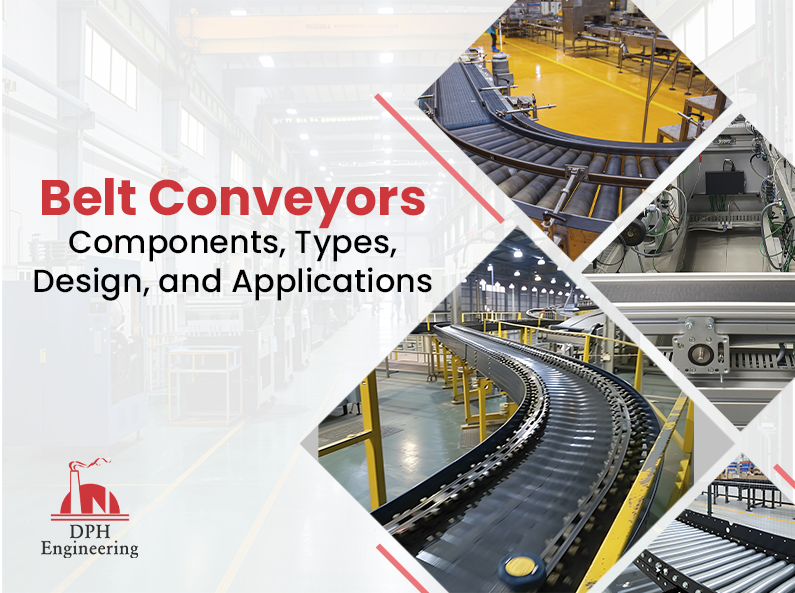What is a Conveyor Belt?
A conveyor belt is a system with a moving belt that runs around two or more wheels. When the wheels turn, the belt moves, carrying items from one spot to another. Conveyor belts are used in many industries to move things quickly and easily over short or long distances. They help in tasks like moving goods, putting things together, sorting items, and loading or unloading. Conveyor belts are important because they make work faster and more efficient.The Working Principle of a Belt Conveyor
A belt conveyor is a machine used to move materials from one place to another using a continuous belt. The main parts of a belt conveyor system are the belt, pulleys, and a motor. The way it works is quite simple: a motor powers a pulley, which turns and moves the belt along with it. The belt moves because of the friction between the pulley and the underside of the belt. This friction creates the force needed to move items in either direction along the conveyor’s path.
The key parts of a belt conveyor system include its frame, drive mechanism, and loading area. The frame is the base that supports the entire system and needs to be strong enough to handle the weight of the materials being transported. The drive mechanism consists of motors and gearboxes that push or pull the belt, moving items along the conveyor. Lastly, the loading area is where materials are placed on or taken off the belt, making it easy for operators to handle the items being moved. Together, these parts create an efficient way to transport materials.
How Conveyor Belt Systems Work?
In a typical conveyor belt system, the belt forms a loop around two or more pulleys, allowing it to keep moving in a continuous cycle. One of these pulleys, called the drive pulley, moves items from one location to another. Most conveyor belts are straight, but some need to turn to get items to their destination. For these turns, cone-shaped wheels or rotors are used to help the belt make the turn smoothly without getting tangled.
Common System Conveyor Belt Parts
Belt Conveyor Systems have several key parts that help them work properly. These parts can vary based on what is being moved and how the system is used, but all conveyor systems have three main parts:
- Belt Support : This part keeps the belt moving smoothly. The support must be strong; if it isn’t, the belt can sag when heavy items are placed on it, leading to slower operation and less efficiency. Keeping the belt tight helps the system run well.
- Pulley : This part controls the belt’s movement. A basic conveyor system has at least two pulleys: one powered pulley that moves the belt and an idle pulley that guides it. More complex systems may have additional pulleys along the frame.
- Drive Unit : This part includes a counter bearing to keep everything moving smoothly. It allows the belt to move in reverse and change direction as needed. Even in systems operated by hand, there is still a drive unit; it just doesn’t have a motor.
How Does the Conveyor Belt Move?
The conveyor belt moves thanks to the drive pulley. When the drive pulley is powered, it spins, creating friction with the belt. This friction pulls the belt and any items on it forward, causing the belt to move continuously.What Speed Do Belt Conveyors Run at?
The speed of belt conveyors can vary widely. For example, Span Tech’s conveyors run at speeds from 100 feet per minute (FPM) to 400 feet per minute (FPM), depending on the specific application and materials being moved.Control Systems and Automation
Most conveyor belts are part of an automated system controlled by a computer or a programmable logic controller (PLC). These controls manage the belt’s start and stop functions, adjust its speed, and direct its movement. Automation helps the conveyor work smoothly with other systems in the facility, making everything run more efficiently.
- Speed Control : You can adjust the speed of a conveyor belt to fit different tasks. Variable speed drives (VSDs) or variable frequency drives (VFDs) control how fast the belt moves, which is useful for handling materials carefully or managing an assembly line.
- Direction Control : Some conveyor belts can move in both directions. This is done by changing the direction of the motor, allowing the conveyor to move materials to and from different spots in the facility. This flexibility is handy for various tasks.
- Sensors and Feedback Loops : Conveyor systems often use sensors to keep track of how the belt is running. These sensors can detect things like the presence of items on the belt, the belt’s alignment, and the load’s weight. They provide real-time information and help make automatic adjustments to keep everything running smoothly and prevent problems like jams.
- Safety Controls : Safety is very important. Conveyor systems include emergency stop buttons, safety switches, and guards to protect workers and materials. These safety features allow the conveyor to stop immediately if there’s an emergency.
Different Types of Belt Conveyor Systems
Now that we understand how conveyor belts work, let’s look at some common types of belt conveyor systems used today:- Sandwich Belt Conveyor : Unlike regular rubber conveyor belts, this type uses two belts instead of one. The belts face each other and move in the same direction, securely holding the items being transported between them.
- Flat Belt Conveyor : This is a simple and cost-effective system, great for large operations. It uses two or more pulleys connected by a flat belt that runs in a continuous loop to move items.
- Incline Belt Conveyor : This conveyor is designed to move items up or down a slope. The belt moves along a fixed path, while the items stay in place on the conveyor bed as they go up or down.
- Curve Belt Conveyor Similar to flat belt systems, these conveyors are designed to move items around curves. They use flexible belts that can bend and twist to follow a curved path.
- Specialty Conveyor Belts : Some conveyor belts are custom-made for specific needs or client requests. These may include motorized pulleys, plastic belts, hinged steel belts, and more, depending on the application.
- Sanitary and Washdown : Conveyors These conveyors are used in industries like food processing and pharmaceuticals where cleanliness is essential. Made from stainless steel, they are easy to clean and maintain to meet hygiene standards.
Explore Our Related Blog

Factors to Consider When Choosing the Right Conveyor Belt for Your Business
When picking the right conveyor belt for your business, consider the following:- Material Handling Needs : Think about what you need to move. If you’re transporting heavy items, you’ll need a strong belt that can handle the weight and wear. For lighter items, a lighter belt might be sufficient.
- Conveyor Length and Width : Choose a belt that fits the size of the items you’re moving and fits in the space available in your facility. The belt should be the right size for your needs to work efficiently.
- Speed and Capacity : The belt’s speed and capacity should match how much material you need to move. For high volumes, you’ll need a belt that can handle more weight and move faster.
- Environment : Consider where the conveyor belt will be used. If it’s in a wet or corrosive area, make sure the belt is resistant to moisture and damage.
- Maintenance : Some belts need more upkeep than others. Choose a belt that is easy to maintain and will last a long time to keep maintenance simple.
- Cost : Think about the overall cost, not just the purchase price. Sometimes cheaper belts end up costing more in maintenance and replacements.
Conclusion
Conveyor belts are essential for efficient material handling in various industries. Understanding how they work and the types available helps in selecting the right system for your needs. Key factors to consider include the type of material, belt size, speed, environment, and maintenance.
DPH Engineering offers expert guidance to help you choose and implement the perfect conveyor belt system for your business. For more details, or contact us for personalized assistance.

